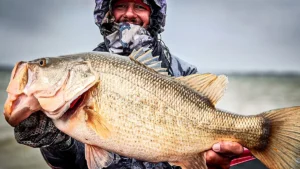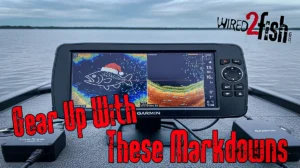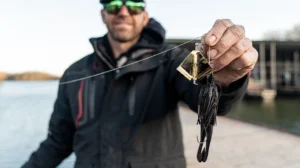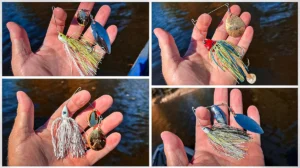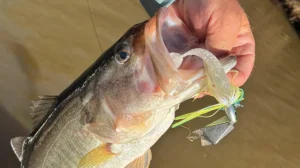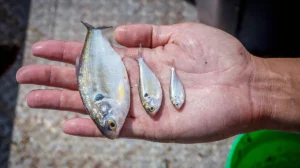Modern jerkbaits are things of beauty. They sport intricate paint jobs, come in assorted lengths and offer lifelike profiles. They look like they could jump from their package and start catching bass by themselves. But there’s more involved in making that happen.
Catching bass with a jerkbait requires a collaborative effort. Rod, reel, and line all contribute to your success, whether you’re looking for prespawners, capitalizing on a shallow summertime smallmouth bite or mimicking shad holed up for winter. Finding the most success requires developing harmony among the parts. That’ll make your line sing from the pull of big bass.
Find A Rod With The Proper Mix Of Action And Power
Your rod is responsible for three things. First, it must send your jerkbait far from the boat. Long casts reduce the chance of spooking bass in clear water, where jerkbaits are most effective. It must create a natural action in your bait. And it must surely set hooks and keep them there as you fight bass back to your boat.
Many spinning rods can easily handle small jerkbaits. But they’re awkward to hold while creating the downward movements that are required to properly twitch a jerkbait. So, choose a casting rod.

The proper casting rod will possess the right mix of action and power. While the latter changes with jerkbait size, the former remains constant. Here’s what you need:
- Action: Your rod should flex from its tip through its midsection. That moderate action allows even the smallest jerkbait to fully load the rod during the back cast, launching it further on the forward cast. It also acts as a shock absorber, keeping trebles pinned.
- Power: Medium power has enough backbone to work small to medium jerkbaits, which measure about 4 1/2 inches long. A medium-heavy power is better for medium to large jerkbaits. Its backbone will cast their additional weight and twitch their larger profiles through the water.
The ranges of lure weight and line weight mirror a rod’s power. While a medium power, such as Abu Garcia’s 7-foot Vendetta, will handle line from 8- to 17-pound test and lures 1/4 to 5/8 ounce, a medium-heavy power may take up to 20-pound test line and a 1-ounce lure.
A Speedy and Smooth Reel Keeps You In Control
While your rod is responsible for presenting your jerkbait, your reel needs to do more than store line. It must be lightweight and comfortable, so you can palm it all day, allowing you to easily twitch your jerkbait. It needs a smooth drag to protect the lightweight line that creates clear-water stealth. And most importantly, it needs to be speedy and smooth.

Each rod twitch creates slack line. Removing it quickly means feeling strikes, which can be subtle, and setting the hook without hesitation. Identified by their gear ratio — at least 7:1 — speedy baitcasting reels efficiently handle line. Trika’s Ti100 casting reel, for example, has a 7:1 gear ratio and consumes 28 inches of line with each handle turn. That’s more than enough to stay in control.
Casts need to be controlled, too. Jerkbaits are relatively lightweight, and casting them through even a bit of wind can be challenging. So besides big gears, look for a reel that’s built for casting distance and control. Shimano’s Curado 150 MGL, for example, is available with a 7.4:1 gear ratio and comes standard with Silent Tune, which supports bearings, Super Free Spool and SVS Infinity spool control. They help you cast your jerkbait farther and worry less about fluffing a big backlash.
Let Conditions Dictate Your Line Choice
Jerkbaits’ dipping and slashing action looks violent. But it’s fragile. Overpower any part of your presentation, and it’s stifled. That’s particularly true when it comes to line size. While 14-pound-test is about as strong as you’ll need, 8-pound-test will serve you well day in and day out.

Besides strength, you need to consider composition. Leave your braided line behind, and spool your reels with fluorocarbon and monofilament. You’ll want both, switching between them as you keep up with water-temperature changes. Here’s when each is best:
- Fluorocarbon: Spool this line, whose matching refractive index makes it disappear under water, when water is at its coldest, mid-40s or colder. It sinks, dragging your suspending jerkbait slightly deeper and forcing it to settle when stopped. Both moves convince sluggish cold-blooded bass to bite.
- Monofilament: As the water warms into the high 40s and beyond, switch to monofilament. It floats, keeping your jerkbait higher in the water column and giving it a livelier action. Monofilament also has a bit of stretch, which will assist your rod in keeping trebles hooked, no matter a bass’s feistiness.
Some days, especially during spring, you’ll want jerkbaits tied to both line types at the ready. Fish the fluorocarbon during the ice-cold mornings. Then, as the sun and southerly breezes warm water and air in the afternoon, forcing you to shed your jacket, switch to the one tied to monofilament.
Take Your Jerkbait Fishing Four Steps Further

Using the best combination of rod, reel and line goes a long way toward making you a better jerkbait angler. But as with most things in life, there’s always room for improvement. Focus on these four points, and you’ll get closer to perfection.
- Keep adjusting weight: A bass’ mood is directly tied to conditions. Match both by changing your jerkbait’s weight by swapping light-wire and heavy-wire hooks, adding or removing lead tape along its belly just behind its bill, or wrapping or removing lead wire from its lead treble. More weight, for example, helps it dive deeper and pause longer, which are best when water is cold.
- Add some freedom: Jerkbaits should have a wide range of movement when worked. Cinching your knot against the line tie removes a lot of it. So, if your jerkbait is lacking one, add a split ring between line and lure. Or use a quality snap, which makes changing lures easy, too.
- Shorten your rod: Most bass anglers gravitate toward rods 7 feet or longer. But those measuring 6 to 12 inches shorter make downward movements — essential to creating the best jerkbait twitches — more comfortable. You can hold your rod nearly vertical and keep its tip out of the water.
- Experiment with cadence: Creating the correct combination of twitches and pauses is key to catching more bass with a jerkbait. Bass usually want shorter pauses and more twitches as water temperature warms. A bite or two will let you know when you’re doing it right for current conditions.



